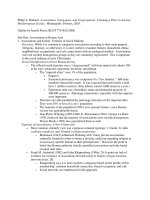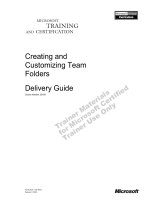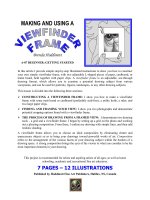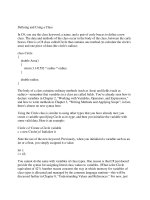Tài liệu Saving and Loading a DataSet from XML pptx
Bạn đang xem bản rút gọn của tài liệu. Xem và tải ngay bản đầy đủ của tài liệu tại đây (35.87 KB, 11 trang )
[ Team LiB ]
Recipe 8.2 Saving and Loading a DataSet from XML
Problem
You need to save a DataSet as an XML file and create a DataSet from an XML file.
Solution
Use the XmlTextWriter and XmlTextReader classes.
The sample code contains three event handlers:
Write Button.Click
Creates a DataSet containing the Orders and Order Details tables from Northwind
and a relation between the two tables. The XML schema and data for the DataSet
is written both to a file and to a text box on the form.
Read Button.Click
Creates a DataSet and reads in schema and data from a file containing a previously
serialized XML. The XML is written from the DataSet to a stream and displayed.
Clear Button.Click
Clears the data grid and the result text box.
The C# code is shown in Example 8-3
.
Example 8-3. File: XmlFileForm.cs
// Namespaces, variables, and constants
using System;
using System.Configuration;
using System.Windows.Forms;
using System.Text;
using System.IO;
using System.Xml;
using System.Xml.Schema;
using System.Data;
using System.Data.SqlClient;
// Table name constants
private const String ORDERS_TABLE = "Orders";
private const String ORDERDETAILS_TABLE = "OrderDetails";
// Relation name constants
private const String ORDERS_ORDERDETAILS_RELATION =
"Orders_OrderDetails_Relation";
// Field name constants
private const String ORDERID_FIELD = "OrderID";
// . . .
private void writeXmlButton_Click(object sender, System.EventArgs e)
{
DataSet ds = new DataSet( );
SqlDataAdapter da;
// Fill the Order table and add it to the DataSet.
da = new SqlDataAdapter("SELECT * FROM Orders",
ConfigurationSettings.AppSettings["Sql_ConnectString"]);
DataTable orderTable = new DataTable(ORDERS_TABLE);
da.FillSchema(orderTable, SchemaType.Source);
da.Fill(orderTable);
ds.Tables.Add(orderTable);
// Fill the OrderDetails table and add it to the DataSet.
da = new SqlDataAdapter("SELECT * FROM [Order Details]",
ConfigurationSettings.AppSettings["Sql_ConnectString"]);
DataTable orderDetailTable = new DataTable(ORDERDETAILS_TABLE);
da.FillSchema(orderDetailTable, SchemaType.Source);
da.Fill(orderDetailTable);
ds.Tables.Add(orderDetailTable);
// Create a relation between the tables.
ds.Relations.Add(ORDERS_ORDERDETAILS_RELATION,
ds.Tables[ORDERS_TABLE].Columns[ORDERID_FIELD],
ds.Tables[ORDERDETAILS_TABLE].Columns[ORDERID_FIELD],
true);
// Bind the default view of the Orders table to the grid.
resultDataGrid.DataSource = ds.Tables[ORDERS_TABLE].DefaultView;
// Write the XSD schema and data to a file.
// Display file dialog to select XML file to write.
SaveFileDialog sfd = new SaveFileDialog( );
sfd.InitialDirectory = System.IO.Path.GetTempPath( );
sfd.Filter = "XML Files (*.xml)|*.xml|All files (*.*)|*.*";
sfd.FilterIndex = 1;
if (sfd.ShowDialog( ) == DialogResult.OK)
{
FileStream fs = new FileStream(sfd.FileName, FileMode.Create,
FileAccess.Write);
// Create an XmlTextWriter using the file stream.
XmlTextWriter xtw = new XmlTextWriter(fs, Encoding.Unicode);
try
{
// Write the XML to the file.
ds.WriteXml(xtw, XmlWriteMode.WriteSchema);
resultTextBox.Text = "XML file written.";
}
catch(Exception ex)
{
MessageBox.Show(ex.Message);
}
finally
{
xtw.Close( );
}
}
}
private void readXmlButton_Click(object sender, System.EventArgs e)
{
// Write the XML schema from a file.
// Display file dialog to select XML file to read.
OpenFileDialog ofd = new OpenFileDialog( );
ofd.InitialDirectory = System.IO.Path.GetTempPath( );
ofd.Filter = "XML Files (*.xml)|*.xml|All files (*.*)|*.*";
ofd.FilterIndex = 1;
if (ofd.ShowDialog( ) == DialogResult.OK)
{
FileStream fs = new FileStream(ofd.FileName, FileMode.Open,
FileAccess.Read);
// Create an XmlTextReader using the file stream.
XmlTextReader xtr = new XmlTextReader(fs);
try
{
// Read the schema into the DataSet.
DataSet ds = new DataSet( );
ds.ReadXml(xtr, XmlReadMode.ReadSchema);
// Bind the default view of the Orders table to the grid.
resultDataGrid.DataSource =
ds.Tables[ORDERS_TABLE].DefaultView;
// Write the XML to a memory stream and display it.
MemoryStream ms = new MemoryStream( );
ds.WriteXml(ms, XmlWriteMode.WriteSchema);
byte[] result = ms.ToArray( );
ms.Close( );
resultTextBox.Text = Encoding.UTF8.GetString(result, 0,
result.Length);
}
catch(Exception ex)
{
MessageBox.Show(ex.Message);
}
finally
{
xtr.Close( );
}
}
}
private void clearButton_Click(object sender, System.EventArgs e)
{
// Clear the data grid and the result text box.
resultDataGrid.DataSource = null;
resultTextBox.Clear( );
}
Discussion
The solution uses the XmlTextWriter and XmlTextReader classes to write and read the
XML data for the DataSet. For more information about these classes, see the Discussion
for Recipe 8.1
and the MSDN Library.
The WriteXml( ) and ReadXml( ) methods of the DataSet are used to write and read the
XML for the DataSet. The WriteXml( ) method takes an optional argument that specifies
a value from the XmlWriteMode enumeration described in Table 8-2
.
Table 8-2. XmlWriteMode enumeration
Value Description
DiffGram
The DataSet is written as a DiffGram, which is an XML format used by
.NET to persist and serialize a DataSet. A DiffGram includes all
information required to recreate the DataSet including original and
current values, row errors, and row order. A DiffGram does not include
information about the DataSet schema.
IgnoreSchema
The DataSet is written without inline schema information. This is the
default.
WriteSchema
The DataSet is written with an inline XSD schema for the relational
structure of the DataSet.
If an in-line schema is not written, the ReadXml( ) method can still be used to read the
data into a DataSet, but the method will not be able to completely recreate the schema for
the DataSet.
The XmlRead( ) method takes an optional argument that specifies a value from the
XmlReadMode enumeration described in Table 8-3
.
Table 8-3. XmlReadMode enumeration
Value Description
Auto
Uses the most appropriate of the following settings:
•
DiffGram if the data is a DiffGram
•
ReadSchema if the DataSet already has a schema or the XML
document contains an inline schema
•
InferSchema if the DataSet does not already have a schema and









